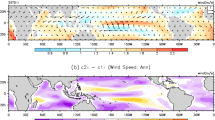Abstract
Using an intermediate ocean–atmosphere coupled model (ICM) for the tropical Pacific, we investigated the role of the ocean dynamical thermostat (ODT) in regulating the tropical eastern Pacific sea surface temperature (SST) under global warming conditions. The external, uniformly distributed surface heating results in the cooling of the tropical eastern Pacific “cold tongue,” and the amplitude of the cooling increases as more heat is added but not simply linearly. Furthermore, an upper bound for the influence of the equatorially symmetric surface heating on the cold tongue cooling exists. The additional heating beyond the upper bound does not cool the cold tongue in a systematic manner. The heat budget analysis suggests that the zonal advection is the primary factor that contributes to such nonlinear SST response. The radiative heating due to the greenhouse effect (hereafter, RHG) that is obtained from the multi-model ensemble of the Climate Model Intercomparison Project Phase III (CMIP3) was externally given to ICM. The RHG obtained from the twentieth century simulation intensified the cold tongue cooling and the subtropical warming, which were further intensified by the RHG from the doubled CO2 concentration simulation. However, the cold tongue cooling was significantly reduced and the negative SST response region was shrunken toward the equator by the RHG from the quadrupled CO2 concentration simulation, while the subtropical warming increased further. A systematic RHG forced experiment having the same spatial pattern of RHG from doubled CO2 concentration simulation with different amplitude of forcing revealed that the ocean dynamical response to global warming tended to enhance the cooling in the tropical eastern Pacific by virtue of meridional advection and upwelling; however, these cooling effects could not fully compensate a given RHG warming as the external forcing becomes larger. Moreover, the feedback by the zonal thermal advection actually exerted the warming over the equatorial region. Therefore, as the global warming is intensified, the cooling over the eastern tropical Pacific by ODT and the negative SST response area are reduced.








Similar content being viewed by others
References
An SI, Kug JS, Ham YG, Kang IS (2008) Successive modulation of ENSO to the future greenhouse warming. J Climate 21:3–21
An SI, Kim JW, Im SH, Kim BM, Park JH (2012) Recent and future sea surface temperature trends in tropical Pacific warm pool and cold tongue regions. Clim Dyn 39:1373–1383
Bjerknes J (1969) Atmospheric teleconnections from the equatorial Pacific. Mon Weather Rev 97:163–172
Cane MA, Zebiak SE, Dolan SC (1986) Experimental forecasts of El Nino. Nature 321:827–832
Cane MA, Clement AC, Kaplan A, Kushnir Y, Pozdnyakov D, Seager R, Zebiak SE, Murtugudde R (1997) Twentieth-century sea surface temperature trends. Science 275:957–960
Clement AC, Seager R, Cane MA, Zebiak SE (1996) An ocean dynamical thermostat. J Climate 9:2190–2196
Compo GP, Sardeshmukh PD (2010) Removing ENSO-related variations from the climate record. J Climate 23:1957–1978
Fang C, Wu L (2008) The role of ocean dynamics in tropical Pacific SST response to warm climate in a fully coupled GCM. Geophy Res Lett 35, L08703. doi:10.1029/2007GL033097
Fu R, Del Genio AD, Rossow WB, Liu WT (1992) Cirrus-cloud thermostat for tropical sea surface temperature tested using satellite data. Nature 358:394–397
Karnauskas KB, Seager R, Kaplan A, Kushnir Y, Cane MA (2009) Observed strengthening of the zonal sea surface temperature gradient across the equatorial Pacific ocean. J Climate 22:4316–4321
Kug JS, Sooraj KP, Jin F-F, Ham Y-G, Kim D (2011) A possible mechanism for El Nino-like warming in response to the future greenhouse warming. Int J Climatol 31:1567–1572
Li T, Hogan TF, Chang C-P (2000) Dynamic and thermodynamic regulation of ocean warming. J Atmos Sci 57:3353–3365
Liu Z (1997) Oceanic regulation of the atmospheric walker circulation. Bull Am Meteorol Soc 78:407–412
Liu Z, Huang B (1997) A coupled theory of tropical climatology: warm pool, cold tongue, and Walker circulation. J Climate 10:1662–1679
Liu Z, Vavrus S, He F, Wen N, Zhong Y (2005) Rethinking tropical ocean response to global warming: the enhanced equatorial warming. J Climate 18:4684–4700
Manabe S, Stouffer RJ (1980) Sensitivity of a global climate model to an increase of CO2 concentration in the atmosphere. J Geophys Res 85:5529–5554
Moritz RE, Bitz CM, Steig EJ (2002) Dynamics of recent climate change in the Arctic. Science 297:1497–1502
Newell RE (1979) Climate and the ocean. Amer Sci 67:405–416
Ramanathan V, Collins W (1991) Thermodynamic regulation of ocean warming by cirrus clouds deduced from observations of the 1987 El Nino. Nature 351:27–32
Ramanathan V, Collins W (1992) Thermostat and global warming. Nature 357:649–650
Seager R, Murtugudde R (1997) Ocean dynamics, thermocline adjustment, and regulation of tropical SST. J Climate 10:521–534
Seager R, Zebiak SE, Cane MA (1988) A model of the tropical Pacific sea surface temperature climatology. J Geophys Res 93:1265–1280
Vecchi GA, Soden BJ (2007) Global warming and the weakening of the tropical circulation. J Climate 20:4316-4340
Wallace J (1992) Effect of deep convection on the regulation of tropical sea surface temperature. Nature 357:230–231
Wang D, Wang J, Wu L, Liu Z (2003) Relative importance of wind and buoyance forcing for interdecadal regime shift in the Pacific Ocean. Sci In China (series D) 46:417–427
Xie S-P, Deser C, Vecchi GA, Ma J, Teng H, Wittenberg AT (2010) Global warming pattern formation: sea surface temperature and rainfall. J Climate 23:966–986
Zebiak SE, Cane MA (1987) A model El Nino-Southern Oscillation. Mon Weather Rev 115:2262–2278
Acknowledgments
We would like to thank two supportive reviewers, and J. Choi who helped us implement the intermediate coupled model. This work was supported by the National Research Foundation of Korea Grant funded by the Korean Government (NRF-2009-C1AAA001-2009-0093042).
Author information
Authors and Affiliations
Corresponding author
Rights and permissions
About this article
Cite this article
An, SI., Im, SH. Blunt ocean dynamical thermostat in response of tropical eastern Pacific SST to global warming. Theor Appl Climatol 118, 173–183 (2014). https://doi.org/10.1007/s00704-013-1048-0
Received:
Accepted:
Published:
Issue Date:
DOI: https://doi.org/10.1007/s00704-013-1048-0




